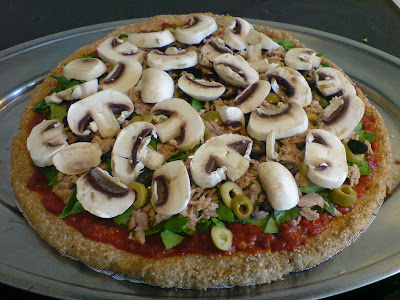Healthy Pizza Basics
This is my debut on this blog, even though a few of my recipes have made their way on here already. Today's lesson - Pizza.
When I was in high school I made spending money doing many different jobs, but I moonlighted as a pizza maker where I learned all kinds of things about how to make a really good pizza. I also learned what not to do, and how most pizza places rip off their customers (because they use really cheap ingredients). Without further adeu, its time to impart my knowledge...
The most important thing when making a pizza is to consider the crust and the sauce. Toppings are simple (as they are usually not prepared in any way other than cutting), but its the sauce and crust that make a really good pizza. For most pizza makers these recipes are highly guarded - and for good reason - their livelihood depends on it being a secret. Another thing to keep in mind is to use a pizza screen for thin crust pizza - circulation is everything for dough that is not pre-cooked. Lastly, the thicker your toppings the longer the cook time (this may be obvious).
Sauce should be more sweet. Dough should not be too sweet. If you follow these rules, you'll probably be on the right track. I've made dough sweet before, and it can work, but the sauce dictates a lot, and when you blend sugar or honey with tomatoes, the result is very good. Here is a pretty good recipe for wholemeal pizza dough (although I don't follow it exactly). The problem with using wholemeal flour is that you wind up with dough that is either too sticky or too dry. Because of this I like to go through the rising stages on the sticky side, and then generously flour the mesh to prevent sticking once the baking begins. Remember that wholemeal flour benefits a lot from multiple rises. Do it right, and you should have something that looks like this.


Now is time for baking. As noted previously, the thicker the topping layer, the longer the cook time. I cook pizzas at 220ºC (or 425ºF), on the middle rack, on the convection setting (if you have it on your oven). A pizza like this takes around 20 minutes, and allow it to cool a few minutes before slicing. The finished result should look somewhat similar to the following.
5 comments:
-
that loooookkkkkkkssss sooooooo yummmmmy!!!!!
-
it WAS yummy!!! MUAHAHA..
-
Kim and I feel like eating this! Kim says he wants to drizzle them with lotsa and lotsa olive oil! =D
-
mmmm the curry chicken one was REALLY good too...i'm going to try drizzling with olive oil next time...thanks for the suggestion :o)
-
mmmm the curry chicken one was REALLY good too...i'm going to try drizzling with olive oil next time...thanks for the suggestion :o)










